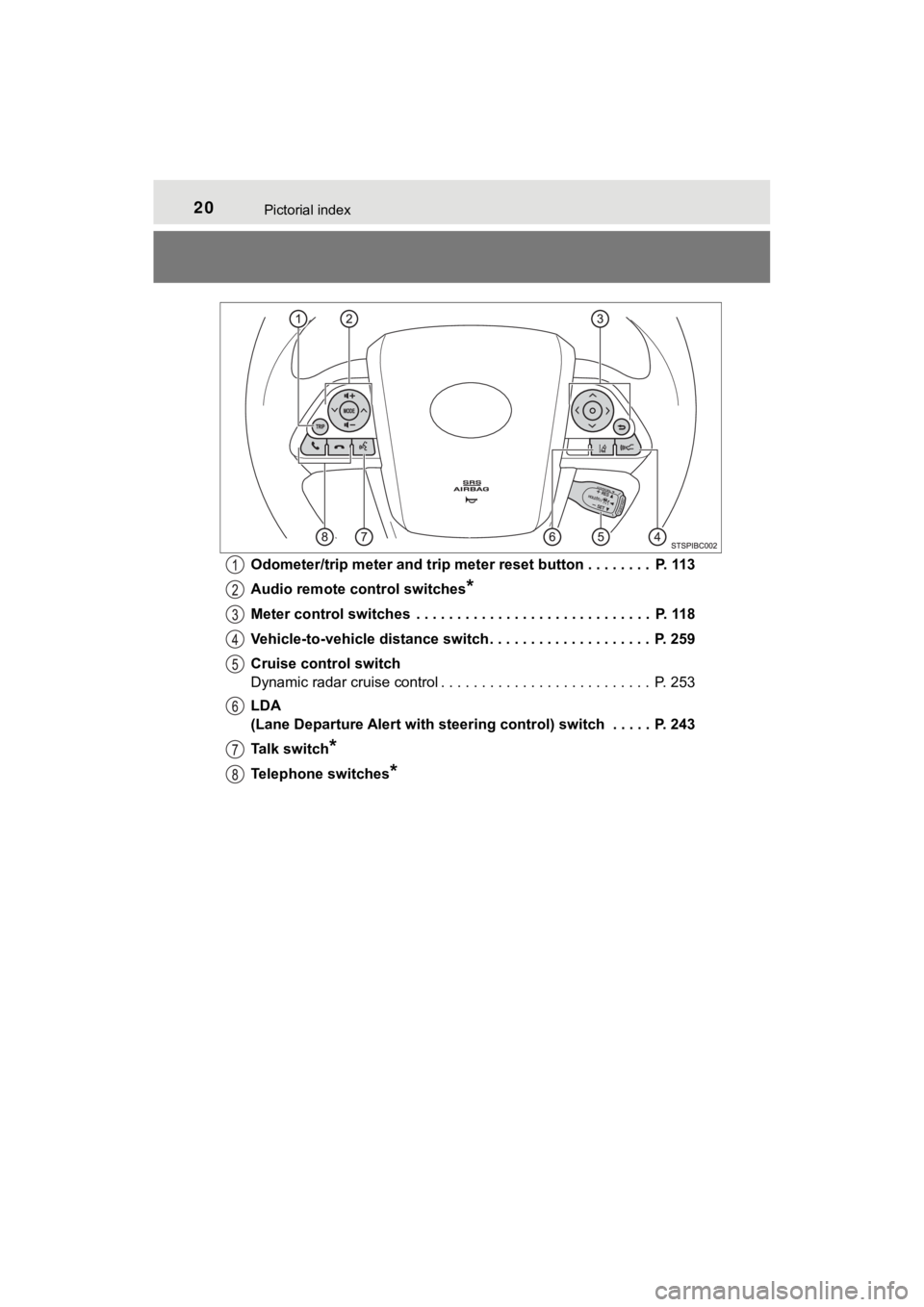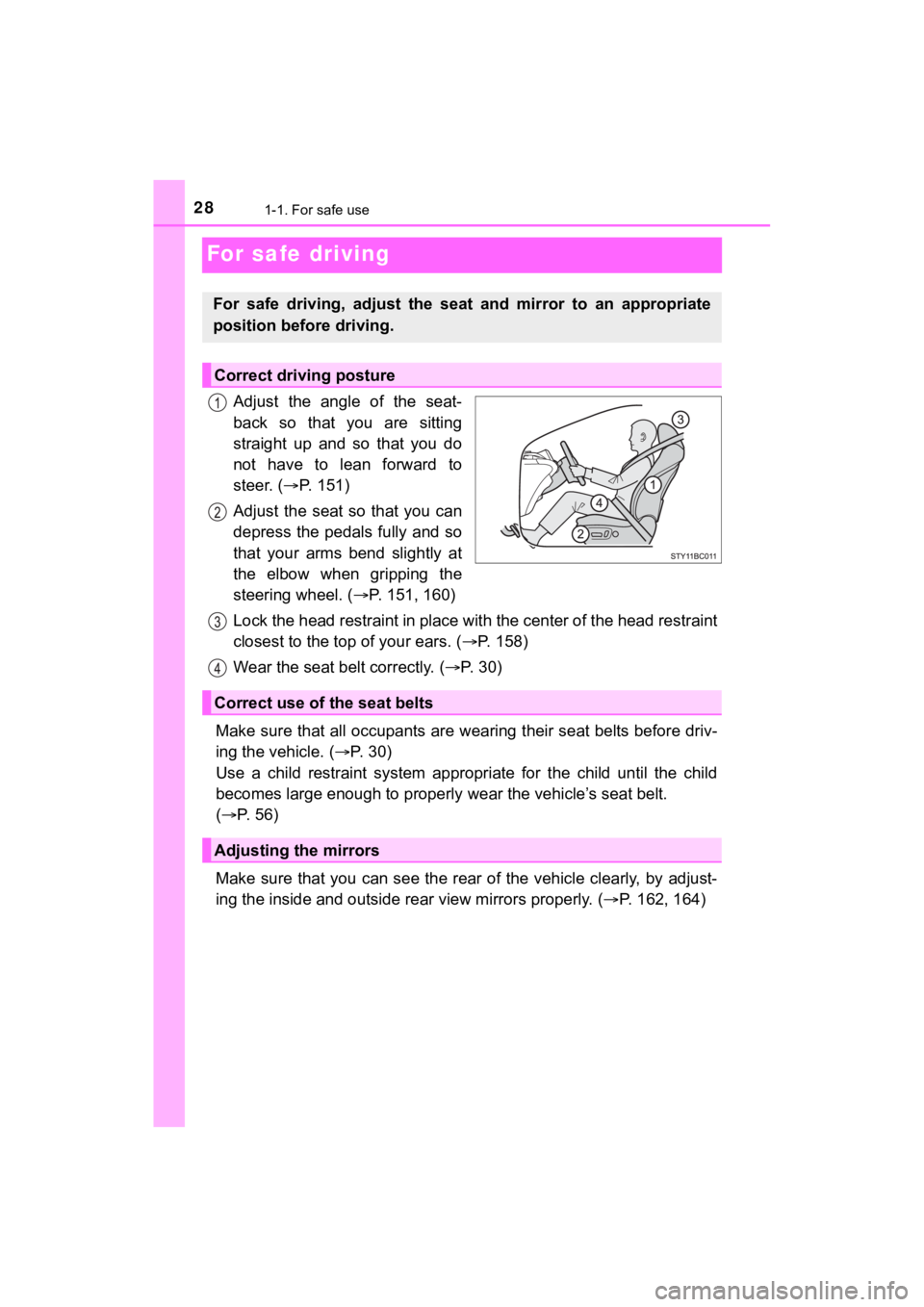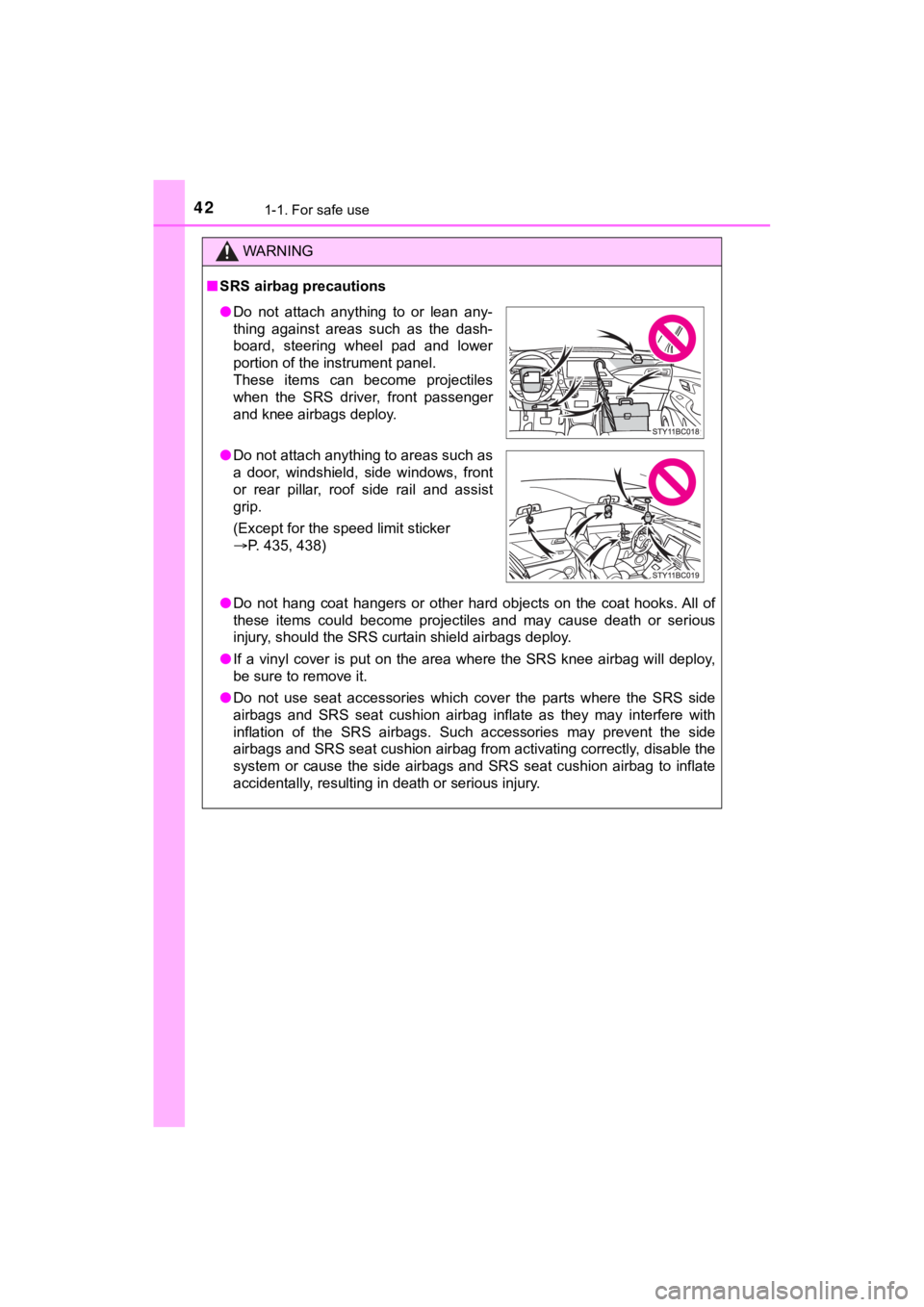steering TOYOTA MIRAI 2020 Owners Manual (in English)
[x] Cancel search | Manufacturer: TOYOTA, Model Year: 2020, Model line: MIRAI, Model: TOYOTA MIRAI 2020Pages: 528, PDF Size: 11.98 MB
Page 2 of 528

TABLE OF CONTENTS2
MIRAI_OM_USA_OM62073UFor your information....................... 6
Reading this manual .................... 12
How to search .............................. 13
Pictorial index .............................. 14
1-1. For safe use
Before driving ...................... 26
For safe driving ................... 28
Seat belts ............................ 30
SRS airbags ........................ 36
Front passenger occupant classification system ......... 49
Safety information for children ........................ 55
Child restraint systems ........ 56
1-2. Emergency assistance Safety Connect.................... 72
1-3. Theft deterrent system Immobilizer system ............. 78
Alarm ................................... 81
Theft prevention labels ........ 83
2. Fuel cell vehicle Fuel cell vehicle characteristics ................... 86
Fuel cell vehicle precautions ....................... 90
Advice for driving fuel cell vehicles ........................... 102 3. Instrument cluster
Warning lights and indicators ......................... 106
Gauges and meters ........... 111
Multi-information display .... 117
4-1. Key information Keys................................... 128
4-2. Opening, closing and locking the doors
Doors ................................. 132
Trunk ................................. 138
Smart key system .............. 143
4-3. Adjusting the seats Front seats......................... 151
Driving position memory .... 153
Head restraints .................. 158
4-4. Adjusting the steering wheel and mirrors
Steering wheel ................... 160
Inside rear view mirror ....... 162
Outside rear view mirrors ............................. 164
4-5. Opening and closing the windows
Power windows.................. 167
1For safety and security
2Fuel cell system
3Instrument cluster
4Operation of each
component
Page 3 of 528

3
MIRAI_OM_USA_OM62073U
1
9 8 6 5
4
3
2
10
7
5-1. Before drivingDriving the vehicle ............. 172
Cargo and luggage............ 180
Vehicle load limits ............. 183
Trailer towing..................... 184
Dinghy towing.................... 185
5-2. Driving procedures Power switch ..................... 186
Transmission ..................... 193
Turn signal lever................ 199
Parking brake .................... 200
5-3. Operating the lights and wipers
Headlight switch ................ 201
Automatic High Beam ....... 205
Windshield wipers and washer ............................ 210
5-4. Refueling Opening the fuel door........ 213 5-5. Using the driving
support systems
Toyota Safety Sense 2.0 ... 218
PCS (Pre-Collision System)..... 226
LDA (Lane Departure Alert
with steering control) ....... 238
RSA (Road Sign Assist) .... 248
Dynamic radar cruise control.............................. 253
Intuitive parking assist ....... 265
Parking Support Brake function
(for static objects) ............ 274
BSM (Blind Spot Monitor)......... 286
• The Blind Spot Monitor function.......................... 289
• The Rear Cross Traffic Alert function ................. 292
Driving assist systems ....... 295
5-6. Driving tips Winter driving tips .............. 301
5Driving
Page 4 of 528

TABLE OF CONTENTS4
MIRAI_OM_USA_OM62073U6-1. Using the air conditioning
system and defogger
Automatic air conditioning system............................. 306
Heated steering wheel/ seat heaters .................... 315
6-2. Using the interior lights Interior lights list ................ 317• Interior lights ................. 318
• Personal lights .............. 318
6-3. Using the storage features List of storage features...... 320• Glove box...................... 321
• Console box .................. 321
• Cup holders .................. 322
• Bottle holders ................ 324
• Auxiliary box ................. 324
Trunk features ................... 325
6-4. Other interior features Other interior features ....... 327• Sun visors ..................... 327
• Vanity mirrors................ 327
• Clock ............................. 328
• Armrest ......................... 329
• Coat hooks.................... 329
• Assist grips ................... 330
• Power outlet .................. 331
• USB charging ports....... 332
• Wireless charger ........... 334
Garage door opener .......... 343 7-1. Maintenance and care
Cleaning and protecting the vehicle exterior .......... 352
Cleaning and protecting the vehicle interior ........... 356
7-2. Maintenance Maintenance requirements ................... 359
General maintenance ........ 361
7-3. Do-it-yourself maintenance
Do-it-yourself service precautions ...................... 364
Hood .................................. 366
Positioning a floor jack....... 367
Motor compartment ........... 369
12-volt battery .................... 374
Tires................................... 378
Replacing the tire............... 386
Tire inflation pressure ........ 393
Wheels............................... 396
Air conditioning filter .......... 398
Electronic key battery ........ 400
Checking and replacing fuses ................................ 402
Light bulbs ......................... 405
6Interior features7Maintenance and care
Page 17 of 528

17Pictorial index
MIRAI_OM_USA_OM62073UParking brake . . . . . . . . . . . . . . . . . . . . . . . . . . . . . . . . . . . . . P. 200
Applying/releasing . . . . . . . . . . . . . . . . . . . . . . . . . . . . . . . . . . P. 200
Precautions against winter season . . . . . . . . . . . . . . . . . . . . . P. 302
Warning buzzer/warning message. . . . . . . . . . . . . . . . .
. P. 420, 426
Turn signal lever . . . . . . . . . . . . . . . . . . . . . . . . . . . . . . . . . . P. 199
Headlight switch . . . . . . . . . . . . . . . . . . . . . . . . . . . . . . . . . . P. 201
Headlights/parking lights/side marker lights/tail lights/
daytime running lights . . . . . . . . . . . . . . . . . . . . . . . . . . . . . . . P. 201
Windshield wiper and washer switch . . . . . . . . . . . . . . . . . P. 210
Usage . . . . . . . . . . . . . . . . . . . . . . . . . . . . . . . . . . . . . . . . . . . P. 210
Adding washer fluid . . . . . . . . . . . . . . . . . . . . . . . . . . . . . . . . . P. 373
Emergency flasher switch . . . . . . . . . . . . . . . . . . . . . . . . . . P. 408
Fuel door opener switch . . . . . . . . . . . . . . . . . . . . . . . . . . . . P. 213
Trunk opener switch . . . . . . . . . . . . . . . . . . . . . . . . . . . . . . . P. 138
Hood lock release lever. . . . . . . . . . . . . . . . . . . . . . . . . . . . . P. 366
Tilt and telescopic steering control switch . . . . . . . . . . . . . P. 160
Adjustment . . . . . . . . . . . . . . . . . . . . . . . . . . . . . . . . . . . . . . . . P. 160
Driving position memory . . . . . . . . . . . . . . . . . . . . . . . . . . . . . P. 154
Air conditioning system . . . . . . . . . . . . . . . . . . . . . . . . . . . . P. 306
Usage . . . . . . . . . . . . . . . . . . . . . . . . . . . . . . . . . . . . . . . . . . . P. 306
Rear window defogger . . . . . . . . . . . . . . . . . . . . . . . . . . . . . . . P. 309
Trunk opener main switch . . . . . . . . . . . . . . . . . . . . . . . . . . P. 139
Navigation system
*
*: Refer to the “NAVIGATION SYSTEM OWNER’S MANUAL”.
Page 20 of 528

20Pictorial index
MIRAI_OM_USA_OM62073UOdometer/trip meter and trip meter reset button . . . . . . . .
P. 113
Audio remote control switches
*
Meter control switches . . . . . . . . . . . . . . . . . . . . . . . . . . . . . P. 118
Vehicle-to-vehicle distance switch . . . . . . . . . . . . . . . . . . . . P. 259
Cruise control switch
Dynamic radar cruise control . . . . . . . . . . . . . . . . . . . . . . . . . . P. 253
LDA
(Lane Departure Alert with steering control) switch . . . . . P. 243
Talk switch
*
Telephone switches*
Page 28 of 528

281-1. For safe use
MIRAI_OM_USA_OM62073U
For safe driving
Adjust the angle of the seat-
back so that you are sitting
straight up and so that you do
not have to lean forward to
steer. (P. 1 5 1 )
Adjust the seat so that you can
depress the pedals fully and so
that your arms bend slightly at
the elbow when gripping the
steering wheel. ( P. 151, 160)
Lock the head restraint in place with the center of the head restraint
closest to the top of your ears. ( P. 1 5 8 )
Wear the seat belt correctly. ( P. 3 0 )
Make sure that all occupants are wearing their seat belts before driv-
ing the vehicle. ( P. 3 0 )
Use a child restraint system appropriate for the child until th e child
becomes large enough to properly wear the vehicle’s seat belt.
( P. 56)
Make sure that you can see the rear of the vehicle clearly, by adjust-
ing the inside and outside rear view mirrors properly. ( P. 162, 164)
For safe driving, adjust the seat and mirror to an appropriate
position before driving.
Correct driving posture
Correct use of the seat belts
Adjusting the mirrors
Page 39 of 528

391-1. For safe use
1
For safety and security
MIRAI_OM_USA_OM62073U
Your vehicle is equipped with ADVANCED AIRBAGS designed based
on the US motor vehicle safety standards (FMVSS208). The airbag
sensor assembly (ECU) controls airbag deployment based on infor-
mation obtained from the sensors etc. shown in the system compo -
nents diagram above. This informat ion includes crash severity and
occupant information. As the airbags deploy, a chemical reactio n in
the inflators quickly fills the airbags with non-toxic gas to h elp restrain
the motion of t he occupants.
WARNING
■SRS airbag precautions
Observe the following precautions regarding the SRS airbags.
Failure to do so may cause death or serious injury.
● The driver and all passengers in the vehicle must wear their se at belts
properly.
The SRS airbags are supplemental devices to be used with the se at belts.
● The SRS driver airbag deploys with considerable force, and can cause
death or serious injury especially if the driver is very close to the airbag.
The National Highway Traffic Safety Administration (NHTSA) advi ses:
Since the risk zone for the driver’s airbag is the first 2 - 3 in. (50 - 75 mm)
of inflation, placing yourself 10 in. (250 mm) from your driver airbag pro-
vides you with a clear margin of safety. This distance is measured from
the center of the steering wheel to your breastbone. If you sit less than
10 in. (250 mm) away now, you can change your driving position in sev-
eral ways:
• Move your seat to the rear as far as you can while still reach ing the ped-
als comfortably.
• Slightly recline the back of the seat.
Although vehicle designs vary, many drivers can achieve the 10 in.
(250 mm) distance, even with the driver seat all the way forward , simply
by reclining the back of the seat somewhat. If reclining the ba ck of your
seat makes it hard to see the road, raise yourself by using a f irm, non-
slippery cushion, or raise the seat if your vehicle has that feature.
• If your steering wheel is adjustable, tilt it downward. This p oints the
airbag toward your chest instead of your head and neck.
The seat should be adjusted as recommended by NHTSA above, whil e
still maintaining control of the foot pedals, steering wheel, and your view
of the instrument panel controls.
Page 42 of 528

421-1. For safe use
MIRAI_OM_USA_OM62073U
WARNING
■SRS airbag precautions
● Do not hang coat hangers or other hard objects on the coat hook s. All of
these items could become projectiles and may cause death or ser ious
injury, should the SRS curtain shield airbags deploy.
● If a vinyl cover is put on the area where the SRS knee airbag w ill deploy,
be sure to remove it.
● Do not use seat accessories which cover the parts where the SRS side
airbags and SRS seat cushion airbag inflate as they may interfe re with
inflation of the SRS airbags. Such accessories may prevent the side
airbags and SRS seat cushion airbag from activating correctly, disable the
system or cause the side airbags and SRS seat cushion airbag to inflate
accidentally, resulting in death or serious injury.
● Do not attach anything to or lean any-
thing against areas such as the dash-
board, steering wheel pad and lower
portion of the instrument panel.
These items can become projectiles
when the SRS driver, front passenger
and knee airbags deploy.
● Do not attach anything to areas such as
a door, windshield, side windows, front
or rear pillar, roof side rail and assist
grip.
(Except for the speed limit sticker
P. 435, 438)
Page 43 of 528

431-1. For safe use
1
For safety and security
MIRAI_OM_USA_OM62073U
WARNING
■SRS airbag precautions
● Do not strike or apply significant levels of force to the area of the SRS
airbag components.
Doing so can cause the SRS airbags to malfunction.
● Do not touch any of the component parts immediately after the SRS
airbags have deployed (inflated) as they may be hot.
● If breathing becomes difficult after the SRS airbags have deplo yed, open a
door or window to allow fresh air in, or leave the vehicle if i t is safe to do
so. Wash off any residue as soon as possible to prevent skin ir ritation.
● If the areas where the SRS airbags are stored, such as the steering wheel
pad and front and rear pillars garnishes, are damaged or cracke d, have
them replaced by your Toyota dealer.
● Do not place anything, such as a cushion, on the front passenger’s seat.
Doing so will disperse the passenger’s weight, which prevents t he sensor
from detecting the passenger’s weight properly. As a result, th e SRS front
airbags for the front passenger may not deploy in the event of a collision.
■ Modification and disposal of SRS airbag system components
Do not dispose of your vehicle or perform any of the following modifications
without consulting your Toyota dealer. The SRS airbags may malfunction or
deploy (inflate) accidentally, causing death or serious injury.
● Installation, removal, disassembly and repair of the SRS airbag s
● Repairs, modifications, removal or replacement of the steering wheel,
instrument panel, dashboard, seats or seat upholstery, front, s ide and rear
pillars or roof side rails
● Repairs or modifications of the front fender, front bumper, or side of the
occupant compartment
● Installation of a grille guard (bull bars, kangaroo bar, etc.), snow plows,
winches, or roof luggage carrier
● Modifications to the vehicle’s suspension system
● Installation of electronic devices such as mobile two-way radio s and CD
players
● Modifications to your vehicle for a person with a physical disa bility
Page 44 of 528

441-1. For safe use
MIRAI_OM_USA_OM62073U
■If the SRS airbags deploy (inflate)
●Slight abrasions, burns, bruising, etc., may be sustained from SRS airbags,
due to the extremely high speed deployment (inflation) by hot g ases.
● A loud noise and white powder will be emitted.
● Parts of the airbag module (steering wheel hub, airbag cover an d inflator) as
well as the front seats, parts of the front and rear pillars, and roof side rails,
may be hot for several minutes. The airbag itself may also be h ot.
● The windshield may crack.
● For Safety Connect subscribers, if the SRS airbags deploy or in the event of
a severe rear-end collision, the system is designed to send an emergency
call to the response center, notifying them of the vehicle’s location (without
needing to push the “SOS” button) and an agent will attempt to speak with
the occupants to ascertain the level of emergency and assistanc e required.
If the occupants are unable to communicate, the agent automatic ally treats
the call as an emergency and helps to dispatch the necessary em ergency
services. ( P. 72)
■ SRS airbag deployment condi tions (SRS front airbags)
● The SRS front airbags will deploy i n the event of an impact tha t exceeds the
set threshold level (the level of force corresponding to an app roximately
12 - 18 mph [20 - 30 km/h] frontal collision with a fixed wall th at does not
move or deform).
However, this threshold velocity will be considerably higher in the following
situations:
• If the vehicle strikes an object, such as a parked vehicle or sign pole,
which can move or deform on impact
• If the vehicle is involved in an underride collision, such as a collision in
which the front of the vehicle “underrides”, or goes under, the bed of a
truck
● Depending on the type of collision, it is possible that only th e seat belt pre-
tensioners will activate.
● The SRS front airbags for the front passenger will not activate if there is no
passenger sitting in the front passenger seat. However, the SRS front
airbags for the front passenger may deploy if luggage is put in the seat,
even if the seat is unoccupied.
● The SRS seat cushion airbag on the front passenger seat will not operate if
the occupant is not wearing a seat belt.